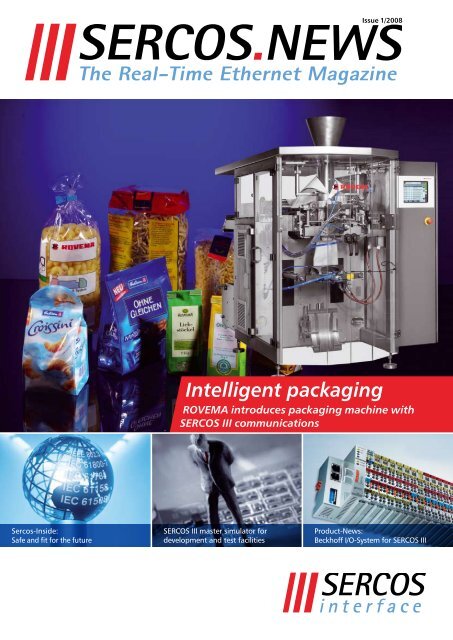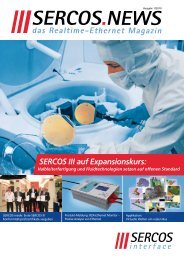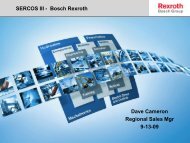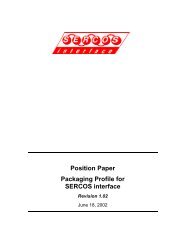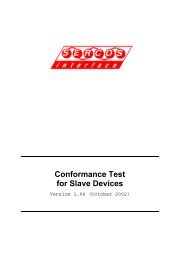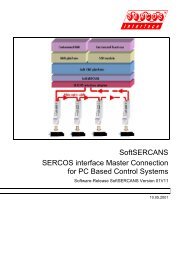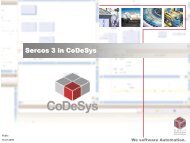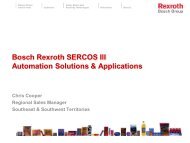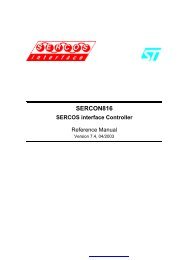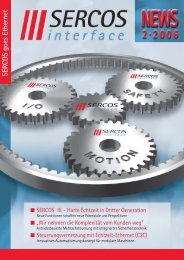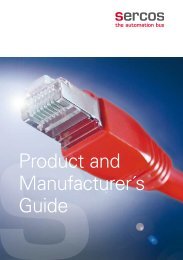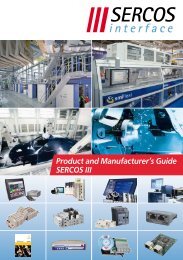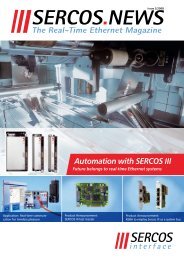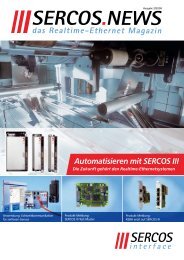SERCOS News - Issue 1 - 2008
SERCOS News - Issue 1 - 2008
SERCOS News - Issue 1 - 2008
Create successful ePaper yourself
Turn your PDF publications into a flip-book with our unique Google optimized e-Paper software.
<strong>Issue</strong> 1/<strong>2008</strong><br />
The Real-Time Ethernet Magazine<br />
Intelligent packaging<br />
ROVEMA introduces packaging machine with<br />
<strong>SERCOS</strong> III communications<br />
Sercos-Inside:<br />
Safe and fit for the future<br />
<strong>SERCOS</strong> III master simulator for<br />
development and test facilities<br />
Product-<strong>News</strong>:<br />
Beckhoff I/O-System for <strong>SERCOS</strong> III
2 Editorial<br />
The Real-Time Ethernet Magazine<br />
Real-time Ethernet:<br />
Speed is not everything!<br />
Ethernet is generally recognized to be a<br />
powerful and future-proof bus system<br />
which is particularly notable for its low<br />
cost and standardized physical design.<br />
Hence it always sounds highly promising,<br />
at least at first, whenever new<br />
types of bus system are based on<br />
Ethernet. At second glance, however,<br />
this image becomes somewhat clouded,<br />
not so much because of the technology<br />
or the possibilities offered by<br />
Ethernet but more because of the<br />
number of incompatible solutions competing<br />
with each in the market.<br />
The latest development is that solutions<br />
are now already being offered<br />
on the basis of Gigabit Ethernet. It<br />
should come as no surprise that the<br />
subject has become an issue for those<br />
companies and users’ organizations in<br />
particular which experience performance<br />
disadvantages because of the<br />
respective transmission method used.<br />
What is not mentioned here is that certain<br />
disadvantages have to be taken<br />
into account if Gigabit Ethernet is used,<br />
such as more complex cabling, for example,<br />
and higher costs and CPU loads<br />
for software-based solutions.<br />
Thanks to its highly efficient protocol,<br />
<strong>SERCOS</strong> III is already able to meet the<br />
performance requirements of all applications<br />
today, meaning that there is<br />
no need to switch to Gigabit Ethernet.<br />
Instead it enables concepts to be implemented<br />
which offer genuine added<br />
value for machine manufacturers. In<br />
particular this means manufacturerindependence<br />
and worldwide acceptance,<br />
as reflected in the standardized<br />
device profiles and the CIP Safety on<br />
<strong>SERCOS</strong> safety concept.<br />
We hope you have an enjoyable read.<br />
Peter Lutz,<br />
General Manager<br />
<strong>SERCOS</strong> International e.V.<br />
Küblerstraße 1, D-73079 Süßen<br />
Phone: +49 (0) 7162/9468-65<br />
Fax: +49 (0) 7162/9468-66<br />
e-mail: p.lutz@sercos.de<br />
www.sercos.de<br />
Quick-Info 1-0801<br />
<br />
<br />
<br />
A1<br />
<br />
<br />
<br />
a<br />
company<br />
<br />
<br />
<br />
<br />
<br />
<br />
<strong>SERCOS</strong> III<br />
Hardware for master and slave<br />
Driver software for master and slave<br />
Controls and IO systems<br />
Starterkits<br />
Design - Consulting - Training<br />
<br />
AUTOMATA GmbH & Co. KG · info@automata.de · www.automataweb.com<br />
Tel. + 49 (0) 82 33 / 79 16 - 0 · FAX + 49 (0) 82 33 / 79 16 - 19
The Real-Time Ethernet Magazine<br />
Sercos-Inside<br />
3<br />
Safe and fit<br />
for the future<br />
Many companies have several networks running in parallel, making it impossible<br />
or unprofitable to communicate with each other. This makes cooperation more<br />
difficult and results in functional losses. Yet it would be helpful if a die-casting<br />
machine was able to report a fault, not just to the staff on site, but also to the<br />
production planning systems, material management as well as the manufacturer.<br />
A direct connection between the PC of a developer located at headquarters and<br />
the control of an assembly line of a subsidiary factory could make updates much<br />
faster and more cost-efficient. Therefore companies are increasingly coming to use<br />
a unified protocol to transfer information from A to B. Here Ethernet and TCP/IP, the<br />
basis of the Internet and office communication, have become dominant.<br />
As factory automation has much higher<br />
requirements as to the robustness,<br />
reliability and safety of the information<br />
networks, Ethernet in the industrial<br />
environment looks somewhat different<br />
from Ethernet in the office. The<br />
most important requirement Industrial<br />
Ethernet has to meet is real-time communication,<br />
i.e. the assurance that important<br />
information will be transferred<br />
immediately or within a guaranteed<br />
time frame. This is the only way to coordinate<br />
complex processes. Common<br />
Ethernet allows a unit to block the line<br />
for all other participants for as a long as<br />
it takes to transmit its data completely.<br />
This leads to the typical "freezing" of the<br />
network, for instance when someone<br />
is sending an e-mail with a volume of<br />
several megabytes to many recipients.<br />
Two seconds of delay may not be a problem<br />
in the office, but in a machine,<br />
which has to coordinate 80 work cycles<br />
per minute, it would be disastrous.<br />
The second important feature is reliability.<br />
Heat, dust and vibration can never be<br />
prevented at a workplace. Strong magnetic<br />
fields may induce currents in cables<br />
that are insufficiently protected. And a<br />
cable failure is always possible where<br />
many parts are moving. None of these<br />
factors may be allowed to jeopardize<br />
the work capabilities, and the same<br />
applies to the safety from external access.<br />
However desirable it is to make communication<br />
easy, unauthorized access<br />
must be prevented in every case.<br />
The term of Industrial Ethernet actually<br />
covers various different practical solutions.<br />
Around a dozen solutions are<br />
offered, six of which – systems such as<br />
<strong>SERCOS</strong> III, PROFINET RT or EtherNet/IP –<br />
can be seen as the relevant market participants<br />
with enough international support<br />
and a sufficient number of clients.<br />
However, there are enormous differences<br />
in some cases. Some systems may<br />
offer real-time functions but with only<br />
limited synchronicity, which guarantees<br />
that several modules work in the same<br />
system cycle. Others are based on a close<br />
connection between the control and<br />
network functionality, which means<br />
that the user is restricted in his choice<br />
of automation systems. Others again<br />
might be open but demand rigid network<br />
planning with numerous control<br />
units which make modifications difficult<br />
and also make simple standard<br />
communication very slow.<br />
Today's field busses and Industrial Ethernet<br />
systems offer some basic functions<br />
which allow carrying out typical control<br />
tasks. As the complexity of the application<br />
increases, the requirements for the<br />
network increase as well. For instance,<br />
real-time applications that require the<br />
precise interaction of several electric<br />
drives or need fast processing of sensor<br />
data depend on a network with a guaranteed<br />
high performance. This is exactly<br />
the domain of <strong>SERCOS</strong> III. Thanks to<br />
Fast Ethernet with a throughput of 100<br />
megabits per second and possible mini-
4 Sercos-Inside<br />
The Real-Time Ethernet Magazine<br />
Block I/O - easy integration of I/O signals<br />
in <strong>SERCOS</strong> III<br />
mum cycle times of only 31.25 µs (the<br />
blink of an eye takes approx. 330,000<br />
µs), the fast transfer of the information<br />
is guaranteed. Also, the architecture<br />
enables direct communication between<br />
the executing units (slaves) so as to keep<br />
reaction times down to a minimum. To<br />
optimise the network, <strong>SERCOS</strong> III does<br />
not require expensive additional network<br />
components, such as switches or<br />
hubs. The integrated network functions<br />
ensure that TCP/IP packets can also be<br />
transmitted next to the real-time data.<br />
The reliability is increased by a robust design,<br />
a ring structure of the lines against<br />
the consequences of a cable break, as<br />
well as the secured data transmission<br />
via a certified safety protocol. The data<br />
is protected automatically, which require<br />
no additional hardware.<br />
Since October 2007, the <strong>SERCOS</strong> III real<br />
time Ethernet solution has been part<br />
of mandatory IEC standards. The vote<br />
for <strong>SERCOS</strong> III as the international standard<br />
was unanimous. This reflects the<br />
worldwide importance of the <strong>SERCOS</strong><br />
interface. <strong>SERCOS</strong> II was already standardized<br />
worldwide. In parallel to standardization<br />
of third generation <strong>SERCOS</strong>,<br />
IEC decided to incorporate the existing<br />
IEC 61491 <strong>SERCOS</strong> II standard into the<br />
new IEC 61158/ 61784-1 standards series.<br />
The <strong>SERCOS</strong> drive profile was included<br />
in the new IEC 61800-7 standard. All<br />
three <strong>SERCOS</strong> generations are now part<br />
of the IEC standards.<br />
2 million <strong>SERCOS</strong> nodes are currently installed<br />
worldwide, and the IEC decision<br />
is goods news for <strong>SERCOS</strong> developers<br />
and users. The evolution of <strong>SERCOS</strong> is<br />
characterized by continuity and a clear<br />
migration path. The common interface<br />
ensures interoperability between<br />
products from different manufacturers<br />
which use the same standardized interfaces,<br />
commands and synchronization<br />
methods. More than 80 different manufacturers<br />
now offer <strong>SERCOS</strong>-enabled<br />
products.<br />
At the field level, which is where communication<br />
between individual drives,<br />
sensors and controllers takes place,<br />
<strong>SERCOS</strong> III real time functions guarantee<br />
the required level of precision. Connectivity<br />
to higher level control systems is<br />
extremely simple. Companies gain direct<br />
access to data at the lowest production<br />
level, and every Ethernet-enabled computer<br />
can be connected to a <strong>SERCOS</strong> III<br />
port without any additional hardware<br />
or software. The computer can link into<br />
corporate TCP/IP communications without<br />
putting production-level runtime<br />
performance at risk.<br />
This works because in addition to real<br />
time communications, <strong>SERCOS</strong> III has a<br />
channel for non real time information<br />
(NRT). The completely transparent integration<br />
of real time and non real time<br />
data enables users to operate a large<br />
mix of devices on the same network.<br />
In contrast to other Industrial Ethernet<br />
solutions, <strong>SERCOS</strong> III does not require<br />
additional hubs and switches, and it<br />
does not use any additional protocols.<br />
Connectivity is completely transparent,<br />
because Ethernet systems without a<br />
<strong>SERCOS</strong> III ID are automatically allocated<br />
to the NRT channel. A 100 Mbit<br />
data rate supports data exchange between<br />
many devices in parallel without<br />
compromising the integrity of real time<br />
communications.<br />
Transparent integration of real time<br />
and non real time data allows companies<br />
to completely rethink their systems<br />
strategies. <strong>SERCOS</strong> III brings two worlds<br />
Highest precision - with cycle times till 31,25µs<br />
together. All nodes speak the same<br />
language. Different modules can even<br />
share the same cables without compromising<br />
integrity and reliability.<br />
<strong>SERCOS</strong> III, like previous <strong>SERCOS</strong> generations,<br />
is based on the field-proven<br />
hardware synchronization solution as it<br />
offers the greatest reliability. Every module<br />
comes with a special logic module<br />
which coordinates the <strong>SERCOS</strong> nodes<br />
with each other. This eliminates any<br />
need for additional expensive con trol<br />
points in the form of hubs and switches,<br />
and the network coordinates itself automatically.<br />
Synchronization is therefore<br />
one of the basic features of every <strong>SERCOS</strong><br />
solution, not a feature which has to be<br />
added on each time with additional<br />
modules or protocols.<br />
At the same time the cycle time of 31.25<br />
μs in real-time mode does not mean<br />
that one individual module would take<br />
up the complete range for itself alone.<br />
Instead, it is possible for up to eight<br />
drives in Motion Control applications<br />
to be supplied with 8 bytes of cyclical<br />
data and for them to send the same<br />
number of diagnoses as well. This is<br />
sufficient for the most demanding tasks<br />
currently conceivable in mechanical<br />
engineering. Even high-precision CNC<br />
machines have minimal cycle times of<br />
500 µs. Thanks to the greater efficiency<br />
of <strong>SERCOS</strong> techno logy it will not<br />
be long before there will be no applications<br />
which would make it necessary<br />
to have a higher network speed. Moreover,<br />
Fast Ethernet also offers sufficient<br />
reserves for TCP/IP communication in<br />
production – especially because <strong>SERCOS</strong><br />
is very efficient in the use of resources.<br />
Flexibility is a success factor in production<br />
and Industrial Ethernet is a protocol<br />
which allows planning and production<br />
to be coordinated with each other with-
The Real-Time Ethernet Magazine<br />
5<br />
Motion and I/O:<br />
Together with <strong>SERCOS</strong> III<br />
<strong>SERCOS</strong> III coupler for the WAGO-I/O-SYSTEM<br />
• Full support for Sercos III V. 1.20 protocol and<br />
<strong>SERCOS</strong> safety based on CIP safety<br />
• Compatible with the <strong>SERCOS</strong> III I/O profile<br />
• Additional I/O fieldbus no longer required<br />
• I/O nodes synchronous with motion cycle<br />
• Redundancy possible through ring topology<br />
• 100 Mbit/s<br />
• Cross communication<br />
• Additional standard IP channel<br />
www.wago.com
6 Sercos-Inside<br />
The Real-Time Ethernet Magazine<br />
Standard ethernet componets - save costs<br />
and simplifies systemarchitecture<br />
out long lead times. In practice, however,<br />
a modern network is expected to<br />
be able to do even more than this. Flexibility<br />
also means being able to combine<br />
individual modules to form new solutions<br />
at low cost. Intelligent control<br />
systems turn machines into reusable<br />
modular systems, the components of<br />
which can be combined anew as requirements<br />
dictate. The network therefore<br />
has to be highly flexible. As a general<br />
rule individual components (slaves) are<br />
controlled by a controller (master). This<br />
results in the typical linear bus structure<br />
of a section of production. In turn, the<br />
individual controllers can communicate<br />
with each other via a joint network, or<br />
gateway, segment.<br />
As well makes it possible for data to<br />
be exchanged directly between a sensor<br />
and a drive which are controlled by<br />
separate controllers. This reduces the<br />
load on the central control system and<br />
also cuts data flows in the network. This<br />
so-called C2C (control-to-control) crosscommunication<br />
between masters, such<br />
as two PLCs, for example, provides the<br />
basis for the distributed control of complex<br />
production lines. This flexibility in<br />
communication, which leads to reduced<br />
reaction times between master or slave<br />
devices and, therefore, in the overall<br />
process, permits the synchronous actuation<br />
of axes at any time, even where<br />
several <strong>SERCOS</strong> networks are involved.<br />
The technology which makes crosscommunication<br />
between the individual<br />
nodes possible not only contributes to<br />
the efficiency and flexibility of <strong>SERCOS</strong><br />
solutions, it also increases safety because<br />
it enables a <strong>SERCOS</strong> III network<br />
to be organized on the basis of a ring<br />
structure. In the event of a cable failure,<br />
therefore, a redundant signal route is<br />
available. This is not the case in the classical<br />
Ethernet which uses switches and<br />
routers for coordinating data flows. The<br />
<strong>SERCOS</strong> network, in contrast, coordinates<br />
itself and offers flexible strategies:<br />
a classical linear structure in order<br />
to save materials or a redundant ring<br />
structure for greater safety. The engineers<br />
have the choice of selecting the<br />
most suitable cabling to meet requirements<br />
without having to think about<br />
additional elements for the network<br />
infrastructure.<br />
The same applies to the safety of data<br />
transmission. <strong>SERCOS</strong> offers a certified<br />
safety protocol as standard to ensure<br />
that information is safely transferred.<br />
<strong>SERCOS</strong> safety complies with the requirements<br />
of safety standard IEC 61508 up<br />
to Safety Integrity Level 3 (SIL 3). This<br />
covers risks arising out of or in connection<br />
with system failures and which may<br />
netX 50<br />
netX 50 – networX on Chip<br />
• 16 or 32 bit network controller with two<br />
communication channels for field bus or real-time<br />
Ethernet with integrated PHY / Switch / Hub<br />
• EtherCAT with 8 FMMUs / Sync-Manager<br />
and 6 KB IO data<br />
• Controller for IO-Link master and CCD sensor<br />
• Hardware platform for IOs and IO-Link gateways
The Real-Time Ethernet Magazine<br />
Sercos-Inside<br />
7<br />
pose a risk to the health of employees,<br />
to the environment, etc. For example, a<br />
sensor used for detecting a dangerous<br />
axis movement or an overheated drive<br />
is also supposed to ensure that the<br />
machine is made safe in a controlled<br />
manner and also switched off. Previously<br />
this required separate cables. <strong>SERCOS</strong><br />
III allows all safety-related information<br />
to be transferred via the existing data<br />
cables so that in the event of an emergency<br />
it can be guaranteed that the<br />
power supply will be shut off if the<br />
emergency stop button is actuated.<br />
The elimination of additional hardware<br />
reduces costs without any compromise<br />
on safety.<br />
<strong>SERCOS</strong> safety is protected against potential<br />
errors such as repeats, losses,<br />
insertions, incorrect sequences, corruption,<br />
delays and the confusion of<br />
secure and standard data. The security<br />
protocol is certified in accordance with<br />
IEC 61508 and was also tested by the<br />
German TÜV in respect of safety requirements.<br />
To ensure that data is transmitted<br />
securely <strong>SERCOS</strong> safety uses the<br />
CIP safety protocol of the ODVA. It is<br />
used by a range of communication<br />
standards such as DeviceNet, Control-<br />
Net and Ethernet/IP and allows users to<br />
use the same safety mechanisms on different<br />
platforms. This makes it possible<br />
to connect several CIP-based networks<br />
together on a consistent basis.<br />
Offering a combination of high performance,<br />
flexibility and verifiable safety,<br />
<strong>SERCOS</strong> III meets all the requirements<br />
of a modern, consistent automation<br />
network. It offers the required everyday<br />
suitability thanks to the field-proven<br />
capabilities of the <strong>SERCOS</strong> protocol<br />
and the forward compatibility of a realtime<br />
Ethernet solution. Thanks to Fast<br />
Ethernet and synchronous cycle times<br />
of 31.25 µs, the third generation of<br />
<strong>SERCOS</strong> not only delivers impressive<br />
performance data at the top end, it also<br />
masters complex automation tasks. For<br />
example, it can allow up to 330 drives<br />
with 4 byte input/output data and 8<br />
digital I/Os each to communicate with<br />
each other in a cycle of a single millisecond.<br />
<strong>SERCOS</strong> III therefore delivers a<br />
level of performance which more than<br />
meets the requirements of today’s<br />
highly developed production machines.<br />
In addition, it also permits the rapid<br />
processing of process data via distributed<br />
I/O modules in central control<br />
systems.<br />
Contact:<br />
Bosch Rexroth AG<br />
Division Electric Drives and Controls<br />
Daniel Grimm<br />
Phone +49 (0) 9352/40-5245<br />
Fax +49 (0) 9352/40-35245<br />
e-mail: daniel.grimm2@boschrexroth.de<br />
www.boschrexroth.de<br />
Quick-Info 1-0802 <br />
netX – The future of communication<br />
netX on Chip netX 5 netX 50 netX 100 netX 500<br />
CPU including –<br />
Product announcement<br />
1st quarter <strong>2008</strong><br />
ARM 966E-S / 200 MHz<br />
8K Data / 8K Inst.TCM<br />
ARM 926EJ-S / 200 MHz<br />
8K Data / 16K Inst.-Cache<br />
8K Data TCM<br />
ARM 926EJ-S / 200 MHz<br />
8K Data / 16K Inst.-Cache<br />
8K Data TCM<br />
Internal memory 64K SRAM 96K SRAM / 64K ROM 144K SRAM / 32K ROM 144K SRAM / 32K ROM<br />
Memory bus (external memory) – SDRAM / SRAM / Flash SDRAM / SRAM / Flash SDRAM / SRAM / Flash<br />
Communication channels<br />
with integrated...<br />
2<br />
Switch / Hub<br />
IEEE 1588<br />
2<br />
PHY / Switch / Hub<br />
IEEE 1588<br />
3<br />
PHY / Switch / Hub<br />
IEEE 1588<br />
4<br />
PHY / Switch / Hub<br />
IEEE 1588<br />
Host interface<br />
8 / 16 / 32 Bit DPM<br />
SPI<br />
8 / 16 / 32 Bit DPM or<br />
16 Bit Extension Bus<br />
8 / 16 Bit DPM or<br />
16 Bit Extension Bus<br />
8 / 16 Bit DPM or<br />
16 Bit Extension Bus<br />
Peripherals<br />
SPI<br />
USB / UART / I2C / SPI<br />
IO-Link-Controller<br />
CCD-Controller<br />
USB / UART / I2C / SPI<br />
PWM / Encoder / ADC<br />
USB / UART / I2C / SPI<br />
PWM / Encoder / ADC<br />
Grafik-Controller<br />
Housing<br />
LBGA 17x17 mm<br />
228 Pins / 1 mm grid<br />
PBGA 19x19 mm<br />
324 Pins / 1 mm grid<br />
PBGA 22x22 mm<br />
345 Pins / 1 mm grid<br />
PBGA 22x22 mm<br />
345 Pins / 1 mm grid<br />
Power supply<br />
Power consumption<br />
Operating temperature<br />
1.8 V / 3.3 V<br />
tbd.<br />
- 40… + 85 °C<br />
1.5 V / 3.3 V<br />
1.2 W<br />
- 40… + 85 °C<br />
1.5 V / 3.3 V<br />
1.5 W<br />
- 40… + 85 °C<br />
1.5 V / 3.3 V<br />
1.5 W<br />
- 40…+ 85 °C<br />
Typical applications<br />
Network-Access-Controller for<br />
diverse Host CPUs<br />
COM-Interface / EA<br />
IO-Link Master / Ident<br />
COM-Interface / EA<br />
Gateway / Motion / Ident<br />
COM-Interface<br />
HMI<br />
For more information, visit www.hilscher.com<br />
or see us at the HANNOVER MESSE <strong>2008</strong> in hall 11, booth 11-A62<br />
www.hilscher.com info@hilscher.com
8 Sercos-Inside<br />
The Real-Time Ethernet Magazine<br />
a<br />
company<br />
<strong>SERCOS</strong> III master simulator for<br />
development and test facilities<br />
The software tool MDT-Parser includes the complete<br />
<strong>SERCOS</strong> III master functionality and runs on Windows ®<br />
XP. Thanks to the integrated script language, the tool<br />
enables the easy programming of test sequences and<br />
supports development of <strong>SERCOS</strong> III slaves and the automation<br />
of system and serial tests. Because the software<br />
components are also available as Windows ® DLLs,<br />
they can be easily integrated in an already existing test<br />
environment.<br />
Free of charge <strong>SERCOS</strong> III<br />
master DLL<br />
The MDT-Parser is based on a complete<br />
master implementation for<br />
passive PCI cards with SERCON100M<br />
FPGA. Beside the main functions like<br />
control of communication phases,<br />
communication via service channel<br />
and exchange of real-time data, all<br />
other services specified by the SER-<br />
COS III standard are supported. The<br />
number of master interfaces and connected<br />
slaves is freely configurable.<br />
Communication settings, properties<br />
of the connected slaves and the communication<br />
links between the connected<br />
devices are defined by means of a<br />
XML configuration file.<br />
The master DLL is available free of<br />
charge and runs under Windows XP.<br />
The necessary real-time environment<br />
and a simple application example are<br />
already included. The installation of<br />
a real-time operating system is not<br />
required.<br />
MDT-Parser<br />
Script language<br />
Besides the <strong>SERCOS</strong> commands the<br />
script language provides variables,<br />
functions to control the program flow,<br />
display functions as well as arithmetic<br />
and bit operations. For the documentation<br />
of procedures and test results<br />
extensive protocol functions are available.<br />
With this feature it is also possible<br />
to record command sequences for the<br />
later execution as script file.<br />
The MDT-Parser is available in different<br />
formats: as a simple console application,<br />
as a tool with a graphical user<br />
interface or as a DLL without own user<br />
interface. The DLL version allows the<br />
easy integration into existing test<br />
environments.<br />
Field of application<br />
Typical application areas for the<br />
<strong>SERCOS</strong> III master DLL and the MDT-Parser<br />
are the development and veri fication<br />
of <strong>SERCOS</strong> III slaves and the device manufacturing<br />
and test facilities. It enables<br />
the quick and easy creation of hardand<br />
software environments needed for<br />
system and production testing.<br />
Contact:<br />
AUTOMATA GmbH<br />
Christoph Melzer<br />
Gewerbering 5 , D-86510 Ried<br />
Phone +49 (0) 8233/7916-0<br />
Fax +49 (0) 8233/7916-99<br />
e-mail: info@automata.de<br />
www.automataweb.com<br />
Quick-Info 1-0803<br />
The software tool MDT-Parser is a<br />
command-line interpreter based on<br />
the <strong>SERCOS</strong> III master DLL. All functions<br />
and services provided by the<br />
master DLL are available as commands.<br />
The command syntax - e.g.<br />
the nomenclature of parameters - is<br />
following the <strong>SERCOS</strong> standard.<br />
Software structure of MDT-Parser
The Real-Time Ethernet Magazine<br />
9<br />
<br />
What all have<br />
<br />
<br />
Only <strong>SERCOS</strong> has<br />
Plug-and-play –<br />
standardized and<br />
non-proprietary.<br />
<strong>SERCOS</strong> III – the independent real-time high-performance fieldbus.<br />
Our customers deservedly expect only the very best solutions for drive and control<br />
technology. The core for such solutions is a comprehensive communication system.<br />
This is why we actively support the development of <strong>SERCOS</strong> III. It incorporates two<br />
standards: the proven real-time mechanisms and the internationally established Ethernet<br />
technology. <strong>SERCOS</strong> III is standardized from the protocol to the unit data, and has been,<br />
from the beginning, designed by a team of people from several companies. As a result,<br />
the high-intelligence devices of Rexroth are unlimitedly compatible for plug-and-play.<br />
Bosch Rexroth. The Drive & Control Company<br />
<br />
Bosch Rexroth AG<br />
www.boschrexroth.com/sercos<br />
<br />
<br />
Hydraulics<br />
<br />
<br />
Pneumatics
10 Application<br />
The Real-Time Ethernet Magazine<br />
ROVEMA introduces packaging machine<br />
with <strong>SERCOS</strong> III communications<br />
At ROVEMA, intelligent packaging means the<br />
responsible, innovative design of individual<br />
components and entire process sequences. The<br />
company supplies complete solutions for sophisticated,<br />
complex packaging applications. Forming,<br />
filling, sealing, case packing and retail packaging<br />
for today‘s market require a holistic approach<br />
which goes beyond the individual component<br />
level to include the specific customer process.<br />
A very powerful and highly flexible<br />
control system is needed to support the<br />
broad product portfolio and the highly<br />
complex packaging operations. Rovema<br />
has been using its own proprietary PCbased<br />
P@ck-Control system for many<br />
years on its packaging machines. Motion<br />
control, PLC and visualization are the<br />
main features of ROVEMA control solutions.<br />
The motion control subsystem is<br />
based on centralized control architecture.<br />
P@ck-Control takes total control of axis<br />
coordination and position control. The<br />
interface to the speed-controlled drives<br />
has traditionally been a conven tional<br />
+/-10Volt interface with incremental<br />
encoder feedback. Interbus-S has provided<br />
the link between the integral software<br />
PLC in the P@ck-Control system<br />
and the outside world.<br />
The engineers at Rovema have designed<br />
the Ethernet-based <strong>SERCOS</strong> III real<br />
time communications system into the<br />
new P@ck-Control generation. A new<br />
VPL260 tubular bag machine with this<br />
communications interface will be on<br />
display for the first time at Interpack<br />
<strong>2008</strong>. The machine also features continuous<br />
volumetric filling. Communications<br />
with the speed-controlled<br />
drives and digital I/Os flow through<br />
the <strong>SERCOS</strong> III interface. Two highspeed,<br />
high-precision linear motors,<br />
which drive the longitudinal sealing<br />
tools, put the real time performance<br />
of the bus system to the test.<br />
There has been general agreement for<br />
some time among the control system<br />
engineers at ROVEMA that the +/-10<br />
Volt interface will have to be replaced<br />
by a future-proof Ethernet-based bus<br />
system. Given the large selection of<br />
systems on the market, it was no easy<br />
task for ROVEMA to make the right<br />
choice. One major criterion was of<br />
course the bus system's ability to support<br />
complex ROVEMA control technology.<br />
The availability of drives and I/Os<br />
and acceptance by ROVEMA customers<br />
worldwide were also important<br />
consi derations. However, support for<br />
ROVEMA - individual packaging solutions<br />
power ful and strictly standardized<br />
communications, I/O and drive profiles<br />
was the decisive factor. The +/-10<br />
Volt interface was able to accommodate<br />
special customer configurations,<br />
and the new solution will have to offer<br />
the same flexibility in the future. To<br />
achieve this goal, the drives and I/Os<br />
have to speak the same language.<br />
Another goal of migration to a stateof-the-art<br />
bus system is to exploit highperformance,<br />
low-cost hardware components<br />
which reduce connectivity<br />
costs. Following an in-depth analysis of<br />
the competing bus systems, the decision<br />
in favor of <strong>SERCOS</strong> III was made<br />
at the beginning of 2007. With the aid
The Real-Time Ethernet Magazine<br />
Application<br />
11<br />
of defined profiles and open standards,<br />
the design team succeeded in integrating<br />
the real time Ethernet system into<br />
our machines within twelve months.<br />
The <strong>SERCOS</strong> III (Serial Real Time Communication<br />
System) is based on the proven<br />
real time mechanism of the <strong>SERCOS</strong><br />
interface. It exploits the principle of cyclic<br />
data transfer in a precisely defined<br />
window. Hardware-based synchronization<br />
provides a solid basis for dependable<br />
implementation of sophisticated<br />
motion control functions, for example<br />
electronic drives and cams in packaging<br />
machines where up to 30 axes have to<br />
execute coordinated, high speed motion<br />
with highly accurate path control .<br />
In parallel with real time processing,<br />
<strong>SERCOS</strong> III can also handle standard IP<br />
data traffic (e.g. TCP/IP). ROVEMA P@ck-<br />
Control can exchange messages with<br />
open, standardized <strong>SERCOS</strong> III interface<br />
gives ROVEMA a universal drive and automation<br />
interface which is compatible<br />
with drives and devices from a whole<br />
range of manufacturers. This interface is<br />
based on the international standards IEC<br />
61784/61158 (communication) and IEC<br />
61800-7 (drive profile), and it offers the<br />
investment protection of standardized<br />
Ethernet to our customers. Susceptibility<br />
to electromagnetic interference is<br />
lower compared to analogue systems,<br />
and simplified wiring along with a<br />
reduc tion in component count enhance<br />
packing machine reliability.<br />
ROVEMA's has introduced third generation<br />
<strong>SERCOS</strong> to support the development<br />
of tomorrow's packaging machines,<br />
and the technology will be on<br />
display at Interpack <strong>2008</strong>. Only one<br />
interface, namely a <strong>SERCOS</strong> III master<br />
The principle<br />
Product enters the system<br />
through the forming tube<br />
The forming collar shapes<br />
the flat film into a round<br />
film tube<br />
Low friction rollers guide the<br />
film to the forming area<br />
Vertical sealing bars seal<br />
the edges of the film<br />
tube together<br />
Film transport belts pull the film<br />
through the forming area<br />
Cross sealing jaws create<br />
top and bottom seals in the<br />
pouches<br />
other devices on the network. <strong>SERCOS</strong> III<br />
supports seamless, future-proof communications.<br />
In combination with the<br />
complex, centralized P@ck-Control automation<br />
system, ROVEMA's Ethernetbased<br />
solution expands existing diagnostic<br />
and remote maintenance capabilities<br />
down to the drive and I/O level.<br />
<strong>SERCOS</strong> III has replaced the traditional<br />
field bus for direct control of I/Os,<br />
monitoring subsystems and other field<br />
bus devices on ROVEMA packaging<br />
machines. This functionality along with<br />
the entire set of motion control functions<br />
will exploit the advantages of the<br />
real time Ethernet system. <strong>SERCOS</strong> III<br />
support for high-speed communications<br />
eliminates the need for additional<br />
hardware in the control computer. The<br />
card, needs to be installed on the PCbased<br />
control computer which is running<br />
P@ck-Control.<br />
Contact:<br />
ROVEMA Verpackungsmaschinen GmbH<br />
Reiner Zentgraf<br />
Industriestr. 1, D-35463 Fernwald<br />
Phone + 49 (0) 641/409-454<br />
Fax + 49 (0) 641/409-397<br />
e-mail: reiner.zentgraf@rovema.de<br />
www.rovema.de<br />
Quick-Info 1-0804 <br />
You expect more than just programming<br />
according to IEC 61131-3?<br />
CoDeSys: Integrated visualization to<br />
be displayed on different clients<br />
(local/target/web)!<br />
More information on our website:<br />
www.3s-software.com/index.shtml?en_Visualization_V3<br />
CoDeSys Users’ Conference:<br />
www.users-conference.com<br />
HANOVER FAIR <strong>2008</strong><br />
Hall 9 - Booth D47<br />
3S-Smart Software Solutions GmbH<br />
Memminger Str. 151 · 87439 Kempten/Germany<br />
Tel. + 49-8 31-5 40 31-0 · www.3s-software.com<br />
We software Automation.
12 <strong>News</strong><br />
The Real-Time Ethernet Magazine<br />
++++ NEWS ++++ NEWS ++++ NEWS ++++ NEWS ++++ Quick-Info 1-0805<br />
Easy-I/O implemented<br />
successfully into the first FPGAs<br />
The single chip controller for the universal<br />
real-time Ethernet solution <strong>SERCOS</strong> III,<br />
which has been available since early 2007,<br />
has been integrated into the first slave<br />
devices. On the basis of the Easy-I/O,<br />
Phoenix Contact was able to make a<br />
digital as well as an analogue Inline block<br />
I/O ready for the market with a minimum<br />
integration effort and therefore in a<br />
minimum of development time. The compact<br />
Inline block I/O modules are used in<br />
particular where a limited number of I/O<br />
signals needs to be processed for little<br />
cost. In addition to the use of the Easy<br />
I/Os in the individual block I/O modules,<br />
Rexroth has integrated the Easy I/O into a<br />
pneumatic valve carrier system, enabling<br />
complete system solution via <strong>SERCOS</strong> III<br />
as a communication system. The licensefree<br />
IP Core for FPGAs has been developed<br />
especially for I/O devices, measuring<br />
sensors, speed sensor and valve<br />
clusters and is available as a free download<br />
for interested parties, together<br />
with a complete documentation. Registration<br />
is done on the <strong>SERCOS</strong> Homepage<br />
www.sercos.de<br />
++++ NEWS ++++ NEWS ++++ NEWS ++++ NEWS ++++ Quick-Info 1-0806<br />
S/IP protocol specification<br />
for <strong>SERCOS</strong> III passed<br />
With the S/IP protocol specification<br />
<strong>SERCOS</strong> International has passed a<br />
further important building block for the<br />
Real-time Ethernet technology <strong>SERCOS</strong> III.<br />
The new protocol enables direct communication<br />
as well as uniform data<br />
exchange between devices, without<br />
a <strong>SERCOS</strong> III master or a subsidiary<br />
<strong>SERCOS</strong> III communication being necessary.<br />
Even in cyclic real time operation<br />
the S/IP protocol can still be used. In<br />
this case the S/IP telegrams are transferred<br />
into the NRT channel (Non Real-<br />
Time) of <strong>SERCOS</strong> III, without having<br />
a negative influence on the real time<br />
behaviour of the network. Apart from<br />
simple reading and writing the parameters<br />
of a device, S/IP also supports<br />
the possibility of combining several<br />
tasks and sending them to the final<br />
device for processing. Furthermore<br />
apart from fixed, preset, standardised<br />
protocol services, manufacturer specific<br />
services can also be added, which<br />
makes <strong>SERCOS</strong> III particularly flexible<br />
for users and developers. With the<br />
new S/IP protocol the vertical integration<br />
of devices into a production system<br />
is improved. The set-up, but also remote<br />
maintenance and diagnosis of <strong>SERCOS</strong><br />
III devices can be carried out by means<br />
of S/IP over the intranet or internet.<br />
++++ NEWS ++++ NEWS ++++ NEWS ++++ NEWS ++++ Quick-Info 1-0807<br />
IXXAT Automation develops portable<br />
safety stack for CIP Safety on <strong>SERCOS</strong><br />
On the basis of a cooperation with<br />
<strong>SERCOS</strong> International, IXXAT develops a<br />
portable stack software for the safety<br />
protocol CIP Safety on <strong>SERCOS</strong>. The<br />
stack uses the SMP (<strong>SERCOS</strong> Messaging<br />
Protocol), which enables the representation<br />
of the CIP data and services on<br />
configured, cyclic data containers in<br />
the <strong>SERCOS</strong> telegram. The stack software<br />
can be used for <strong>SERCOS</strong> master as<br />
well as <strong>SERCOS</strong> slave implementation<br />
and consists of a CIP Safety layer and a<br />
CIP Safety on <strong>SERCOS</strong> adaptation layer.<br />
The software will be pre-certified by<br />
TÜV and BGIA according to IEC 61508<br />
SIL3 to facilitate considerably the development<br />
and certification of safetyrelevant<br />
automation devices. Beside<br />
the cooperation relating to CIP Safety<br />
on <strong>SERCOS</strong>, the company IXXAT is also<br />
planning to realize a <strong>SERCOS</strong> III interface<br />
module based on the universal<br />
IXXAT “Industrial Ethernet Module”,<br />
where the complete <strong>SERCOS</strong> III functionality<br />
is integrated into an FPGA component<br />
by the manufacturer Altera and<br />
made available for connection to host<br />
systems via a universal interface.
The Real-Time Ethernet Magazine<br />
Sercos-Inside<br />
13<br />
Workshops·Fairs·Roadshows<br />
Exhibitions<br />
Plug-Fest<br />
Hannover Messe <strong>2008</strong> FA/PA <strong>2008</strong> SPS/IPC/DRIVES <strong>2008</strong> ISW, University of Stuttgart<br />
April 21–25, <strong>2008</strong>, Hannover June 10–13, <strong>2008</strong>, Beijing November 25–27, <strong>2008</strong>, Nuremberg May 28-29, <strong>2008</strong><br />
Seminars<br />
Roadshow / China<br />
User Seminar<br />
Beijing/Shanghai/Guangzhou/Shenyang/Wuhan<br />
June 11, <strong>2008</strong>, Beijing/China September 15–26, <strong>2008</strong><br />
End of September <strong>2008</strong>, Paris/France<br />
For further information please contact:<br />
October 14, <strong>2008</strong>, Munich/Germany<br />
Developer Seminar<br />
<strong>SERCOS</strong> International e. V. · Peter Lutz<br />
Phone: +49 (0)7162/9468-65<br />
October 15, <strong>2008</strong>, Munich/Germany<br />
Fax: +49 (0)7162/9468-66<br />
info@sercos.de<br />
Quick-Info 1-0808<br />
Impressum<br />
Publishing, concept and design:<br />
STROBL GmbH, Ilsfeld-Auenstein, Phone +49 (0) 70 26 / 9 60 17<br />
e-mail: info@stroblgmbh.de<br />
Responsible for content: Peter Lutz, <strong>SERCOS</strong> International e. V.<br />
Publication does not imply that the solutions described or the<br />
designations used not protected by trademark, patent or<br />
intellectual property rights.<br />
Real-Time Ethernet in the format of the industrial standard<br />
Communication interfacing using a serial host or shift register<br />
interface has become a standard on the market.<br />
With the netIC, Hilscher makes a compatible hardware available<br />
for all real-time Ethernet systems equipped with two ports and<br />
integrated PHYs, Hub und Switch.<br />
• Modbus RTU protocol as a host interface<br />
• UART, SPI, I2C, shift register interface<br />
• Direct connection to 2x RJ45 port and LEDs<br />
• 3.3V supply voltage, 32 pin DIL base, 21 x 42 mm<br />
For more information, visit www.hilscher.com<br />
or see us at the HANNOVER MESSE <strong>2008</strong> in hall 11, booth 11-A62<br />
www.hilscher.com info@hilscher.com
14 Product-<strong>News</strong><br />
The Real-Time Ethernet Magazine<br />
Quick-Info 1-0809 <br />
I/O system for Sercos III<br />
Bus Coupler EK9750<br />
for <strong>SERCOS</strong> III networks<br />
www.beckhoffautomation.com<br />
With the new EK9750 Bus Coupler, Beckhoff provides an I/O solution<br />
for Sercos III networks. The powerful and ultra fast I/O system<br />
will be available for Sercos III, making a large selection of terminals<br />
available for users. The Terminal system distinguishes itself by<br />
its high performance, flexible topology and simple configuration.<br />
Distributed I/Os can be inexpensively integrated into an industrial<br />
network. The coupler supports the new Sercos III I/O profile and<br />
communicates seamlessly in Sercos III networks.<br />
Beckhoff relies on open, international standards and communication<br />
interfaces for their entire automation portfolio, to the advantage<br />
of their users.<br />
Quick-Info 1-0810 <br />
First soft master implementation for <strong>SERCOS</strong> III<br />
<strong>SERCOS</strong> III Master based on Software<br />
for demanding Motion-solutions<br />
www.profimatics.com<br />
Current <strong>SERCOS</strong> III products use a specific <strong>SERCOS</strong> lll hardware for<br />
both the master and the slave. This hardware takes on important<br />
functions, in order to ensure quick processing and synchronization<br />
of real-time data. With the soft master introduced for the first time<br />
by Profimatics a <strong>SERCOS</strong> III Master can now be realized without using<br />
special hardware. Instead of that, a standard Ethernet controller is<br />
used. The <strong>SERCOS</strong>-specific hardware functions are moved to the<br />
hardware-related and real-time capable part of a master driver; so<br />
that the master can be realized completely in software.<br />
With the help of modern processors and network controller the soft<br />
master can also be used for demanding motion applications. Furthermore<br />
it is compatible with normal<br />
<strong>SERCOS</strong> III networks which facilitates the<br />
implementation of this solution into existing<br />
applications of the user.<br />
Quick-Info 1-0811 <br />
Rexroth IndraMotion MLC: Powerful System Solution with<br />
Motion, Logic and Robot Control<br />
More power with more functions:<br />
Rexroth IndraMotion MLC<br />
www.boschrexroth.com<br />
Rexroth offers its controller-based control system IndraMotion MLC<br />
in a new version combining motion and logic control with robot<br />
control on a uniform platform. In addition to the 32-axis solu tion,<br />
IndraControl L65 now provides a more powerful device version<br />
with 64 axes for all applications with high motion control requirements.<br />
The IndraControl L65 control platform is a powerful hardware<br />
version permitting synchronization of up to 64 axes. This control<br />
platform uses Ethernet-based <strong>SERCOS</strong> III as standard drive interface<br />
and for controlling the master axis<br />
network. Another new system function<br />
of IndraMotion MLC is the control of hydraulic<br />
drives.
The Real-Time Ethernet Magazine<br />
Product-<strong>News</strong> 15<br />
Quick-Info 1-0812 <br />
Digital and Analog I/Os on <strong>SERCOS</strong> III<br />
Inline Block I/O on <strong>SERCOS</strong> III<br />
www.phoenixcontact.com<br />
The new <strong>SERCOS</strong> III digital and analog module from Phoenix<br />
Contact’s compact Inline Block IO product line lets you quickly and<br />
easily connect sensors and actuators to the <strong>SERCOS</strong> III network.<br />
The digital module features 16 digital inputs and 16 combined<br />
digital inputs and outputs. The combined input/output channels<br />
can function without internal parameterization by simply connecting<br />
a sensor or actuator. The low delay times of the inputs and<br />
outputs (ton typ. 50 µs, toff typ. 150 µs) allows the use of control<br />
programs such as a motion control application.<br />
The analog module has four inputs and two outputs that can be<br />
configured individually and independently of each other. The four<br />
differential inputs can receive analog current signals of 0 mA to 20 mA,<br />
4 mA to 20 mA and ±20 mA or voltage signals of 0 V to 10 V, ±10 V,<br />
0 V to 5 V and ±5 V and also measure the temperature by means<br />
of a resistance thermometer (RTFs) Current and voltage signals are<br />
available for each channel on the output side. Both the inputs and<br />
the outputs feature 16-bit resolution. Due to its short conversion<br />
times and fast process data operation, the analog version is particularly<br />
well-suited for testing and control<br />
applications.<br />
netSwitch with Ethernet-Port for <strong>SERCOS</strong> III<br />
The Real-Time-Ethernet system <strong>SERCOS</strong> III realizes a deterministic, jitterfree data<br />
transmission to control and synchronize drives or other decentralized devices. On<br />
the basis of a time-slot mechanism, any other Ethernet frames can be transmitted in<br />
the so-called NRT channel (Non-Real-Time). For this, the frames have to be inserted<br />
synchronously into the <strong>SERCOS</strong> network and buffered in case of higher data traffic.<br />
• links <strong>SERCOS</strong> III with Standard Ethernet network<br />
• simple configuration and status via web interface<br />
• 64 KB buffer memory for Ethernet telegrams<br />
• with one or four Ethernet ports<br />
For more information, visit www.hilscher.com<br />
or see us at the HANNOVER MESSE <strong>2008</strong> in hall 11, booth 11-A62<br />
www.hilscher.com<br />
info@hilscher.com
FAX-RESPONSE<br />
The Real-Time Ethernet Magazine<br />
<strong>SERCOS</strong> NEWS - QUICKFINDER<br />
■ Quick-Info 1-0801 · Fax: +49 (0) 7162/9468-66<br />
■ Quick-Info 1-0802 · Fax: +49 (0) 9352/40-35245<br />
■ Quick-Info 1-0803 · Fax: +49 (0) 8233/7916-99<br />
■ Quick-Info 1-0804 · Fax: +49 (0) 641/409-397<br />
■ Quick-Info 1-0805 · Fax: +49 (0) 5235/34-1200<br />
■ Quick-Info 1-0806 · Fax: +49 (0) 7162/9468-66<br />
■ Quick-Info 1-0807 · Fax: +49 (0) 751/56146-29<br />
■ Quick-Info 1-0808 · Fax: +49 (0) 7162/9468-66<br />
■ Quick-Info 1-0809 · Fax: +49 (0) 5246/963-198<br />
■ Quick-Info 1-0810 · Fax: +49 (0) 4123/928284<br />
■ Quick-Info 1-0811 · Fax: +49 (0) 9352/40-35245<br />
■ Information<br />
■ Contact<br />
■ Quick-Info 1-0812 · Fax: +49 (0) 5235/34-1200<br />
Contact form<br />
Please fill out completely<br />
Company:<br />
Dept.:<br />
First name:<br />
Last name:<br />
Street:<br />
Post / ZIP Code:<br />
City:<br />
Phone:<br />
Fax:<br />
e-mail:<br />
Internet:<br />
Yes,<br />
I am interested in <strong>SERCOS</strong> and <strong>SERCOS</strong> III.<br />
Please send me more information.<br />
Fax: +49 (0) 7162-9468-66<br />
<strong>SERCOS</strong> International e. V.<br />
Küblerstraße 1 · D-73079 Süßen · Phone: +49 (0)7162/9468-65 · Fax: +49 (0)7162/9468-66<br />
e-mail: info@sercos.de · Internet: www.sercos.de


